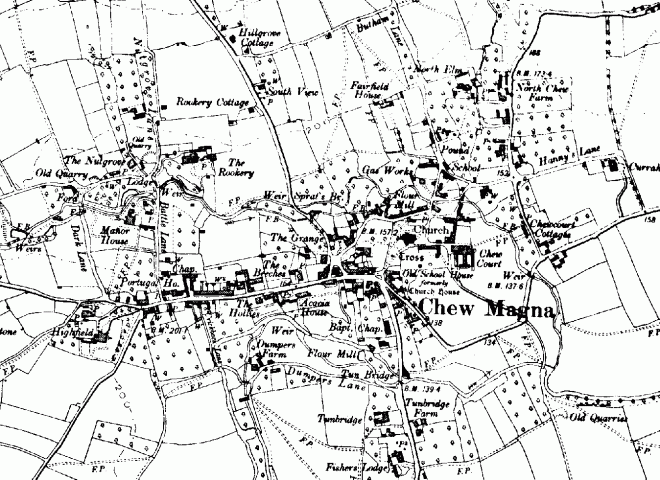
The first date we can be sure of in the story of our Peters ancestors is November 23rd 1713 when Robert Peters, a yeoman of Chew Magna married Mary Horwood, also of Chew at Wells, in the Cathedral of St Andrew. Mary was the eldest daughter of John Horwood of Bristol, a house carpenter, whereas Robert’s background is harder to pinpoint. A licence for the marriage had been granted at the bishop’s court in Wells and the entry for the marriage appears in the Cathedral register.
Whilst Mary’s family has been dealt with in earlier articles, it is worth looking at the general background of the Peters family in Chew before considering Robert and Mary’s family.
Although there is no record of the baptism or birth of Robert in Chew Magna parish records, it can assumed he belonged to the same family as many other individuals who appear in the parish register and other documents. The Peters family had lived in the village since at least the 1630s. The first entry in the register to mention them is a burial in 1637 of John Peters, and then between 1642 and 1685 thirteen children are baptised being named as the offspring of either a Thomas or a Tobias (or Toby) Peters. I had imagined the family had moved into the parish at this time, were it not for the fact that one of these baptisms reads as follows:
January 7th 1656/7 Mary the daughter of Tobias Peters alias Welch
Now aliases were quite a common feature in the 17th and 18th centuries and have no sinister connotations. It simply means that Tobias was known by two different surnames and this state of affairs occured quite often with second marriages, step children and for reasons of inheritance. But in this case I went again to the parish register and looked for entries with the name Welch or Welsh. These start in 1579 with the marriage of a Peter Welsh to Edith Chinerton and end abruptly in 1644 with a baptism of Joane Welch. There is also a Thomas Welsh, who was buried in 1631 and three of his sons were named John, Thomas and Tobit (another form of Tobias). Is it possible that these three men are the same as the first three Peters to be recorded in the register? There are no Welsh/Welch entries after 1644 and no Peters entries before 1637. It could be that the family had moved to Somerset from Wales and still used the patronymic system normal there. If Thomas was the son of a Peter he would be Thomas ap Peter, but the to locals in Chew he would be Thomas Welsh. It’s only a theory but it is interesting to note that there was another family in the village at this time called Davis alias Welshman. I think Robert was a grandson of Tobias Peters alias Welsh and was born around 1685.
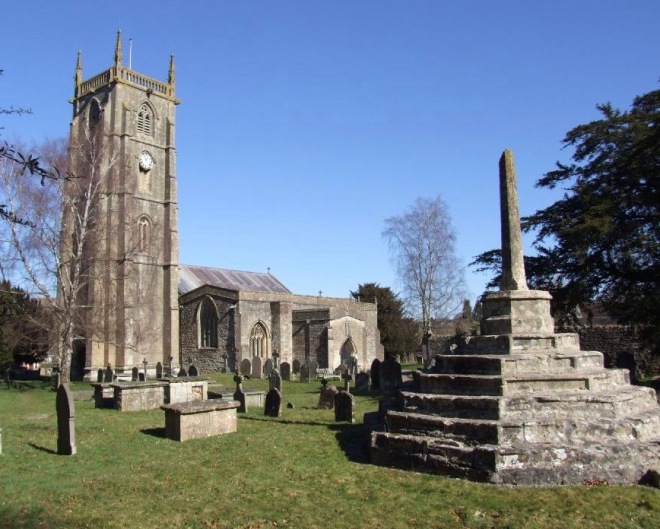
St Andrew, Chew Magna
Robert and Mary had at least eight children and the first record of them is an entry in the baptismal register of St Andrew, Chew Magna in 1724, which reads:
Mary, Ann, Hester, Margaret, John, Children of Robert Peters & Mary
his wife (the parents professing Quakerism & for that reason Baptism
was delayed beyond the usual time) Ye eldest about 5 or 6 years old were
Baptised April 1st
Hum. Buckler Vicar
Two further daughters, Martha and Frances were baptised in 1727; they may have been twins, but there is no proof, and a final son, Robert was born in 1731. There is a problem with these records in that the will of Mary’s father, John Horwood in 1744, names eight Peters grandchildren, but there is an Elizabeth yet no Ann. It would also seem strange that no child was born to Robert and Mary between their marriage in 1713 and 1718. In John Horwood’s will it implies that Elizabeth Peters was living in his house in Bristol and it looks as if she was the eldest grandchild – her name always appears first in any listing and she receives the remainder of John’s household possessions not otherwise bequeathed. I therefore think that she was born c1714/5, and by 1724 was living with her grandfather, in the same way that her mother, Mary had lived with her grandfather, John Heale. She seems therefore to have always lived in Bristol, for following her grandfather’s death she married there and continued to live in the city. She was presumably also raised in the Quaker faith whereas her parents had, it appears, joined the Anglican community.
What then of Ann? It may be that she died young, although there is no entry in the burial register, or she may be the Ann Peters who married Richard Cox in Chew on May 13th, 1744. If the latter, it is still strange that she is not mentioned in John Horwood’s will which was drawn up in November of that year, when he twice refers to “my eight grandchildren”. Perhaps the marriage displeased the family and that is why John was so adamant that the remaining grandchildren should not receive their portion if their marriages went against the wishes of their mother and aunt. However it may be that John had already provided for Ann on her marriage, and therefore she was excluded from the bequest.
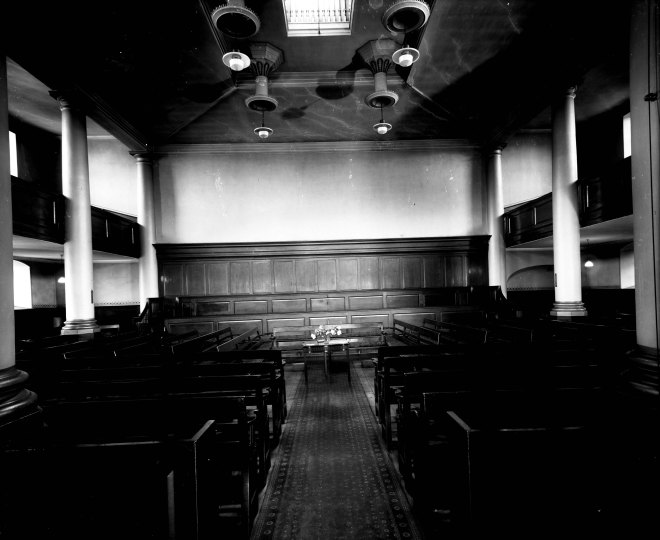
Interior of the Quaker Meeting House at Quakers Friars, Bristol
Three of the Peters children married within eighteen months of John Horwood’s death on May 18th 1745. Margaret married William Pow, a cordwainer in Chew parish church in May 1746 and Elizabeth married Anthony Lawrence, a shoemaker at the Quaker Meeting House at Quakers Friars in June of the same year. Although the record hasn’t been found, Hester married Richard Edgell, a horse driver and collier around the same time.
We have seen in the previous story of the Harwood family that Mary’s two unmarried sisters, Elizabeth and Margaret died on the same day and were buried on the same occasion in November 1746, just 18 months after their father, John. Elizabeth had been the sole executrix of her father’s will, but at some time after his death she commited an act which was to divide the family. John Horwood left the sum of £400 to his eight Peters grandchildren, to be paid at their marriage, £50 apiece. By their marriages Elizabeth, Hester and Margaret had gained their portion, but Elizabeth Horwood converted the remaining £250 from an interest-bearing deposit with Stephen Stone, a Bristol currier, into a bond with the same individual, in her own name. In her will Elizabeth Horwood left the bulk of her personal estate to Hester Edgell and Margaret Pow and appointed them her executrices. The sisters and their husbands apparently declared that they would call in the bond and use the money for their own purposes, only paying out the remaining £50 bequests on the respective marriages of their siblings as and when they occurred, from their own resources. This prompted Robert Peters, on behalf of his children, to take the affair to the Court of Chancery and a document of February 1747 states their case before the Lord High Chancellor. The complainants obviously feared that the monies would be subject to “Misapplication or Wasting” by Edgell and Pow and that their bequests might never materialize. They asked for the Court to take charge of the Bond and apply it as John Horwood wished. Sadly we do not know how this family feud ended. Any response by the accused has not yet been discovered. Indeed, none may have been made and the threat implied by going to Chancery may have persuaded Edgell, Pow and their wives to desist, and for a settlement to be agreed. Margaret Pow named her two eldest children Mary and Robert, so perhaps family unity was restored to some degree. Two more of the Peters children married in the following year – John to Ann Fear and Martha to James Plumley, so one hopes they received their £50. Robert, the youngest, was not to marry until 1762, and of the remaining two sisters, Mary and Frances, nothing more is known. What makes the situation more interesting are some transactions involving leases of the land in Chew Magna which were previously held by John Heale and had passed to the Horwoods and then the Peters.

Chancery pleading by the Peters family 1747
John Heale the baker of Bristol, had acquired a dwelling house and land in Chew Magna and seems to have lived there from the early 1690s. A new lease from the manor of Chew of 1696 gives details of his holdings with several named fields and closes. When John died in 1710 he left this to his granddaughters Mary and Elizabeth Horwood. Another lease in 1715 grants a part of this to Mary’s husband, Robert Peters in his own name. The remaining, and major part of the property, was granted in a new lease of 1731 to John Horwood who, at his death in 1745, left part to John and part to Robert Peters, his grandsons.
In May 1747, just three months after the Chancery pleading was issued, Richard Edgell and William Pow were granted a lease from the manor of Chew for what seems to be the land bequeathed to Robert Peters the younger by John Horwood. They paid £40 for the reversion and were to come into the estate on young Robert’s death. This seems an odd transaction considering they were probably twice Robert’s age, but possibly it was a method of “keeping it in the family” should Robert die childless; in fact he lived another 50 years and records show his sons and grandsons still farming the same land in the 1840s. Later in 1747 Edgell and Pow were assigned part of the land of John Peters, the younger son of Robert and Mary. Possibly these deals were part of a settlement following the upheaval of the Chancery case.
At this point it is worth turning to the situation of the wider Peters family in Chew Magna before returning to the family of Robert and Mary. I have mentioned that Robert was probably connected to some of the Peters mentioned in parish records, although there is no conclusive evidence. It is almost certain that some entries were missed from the registers, and furthermore the Quaker registers for North Somerset are patchy; however it is possible to reconstruct some of the relationships, and the naming patterns give further clues.
Tobias Peters alias Welch, whom we have met earlier, had one son, another Tobias and he lived 1650-1734 and married (date unknown) a lady named Anne. The baptismal register at Chew records the four sons (Tobias, Edward, John and Arthur) and a daughter Frances, of Tobias and Anne. Also recorded are marriages for all of these apart from John. Later documents reveal that of the four sons, Tobias and Arthur were weavers; now a lease of 1715 mentions a brother of our Robert Peters named John who is a weaver and who appears to be unmarried. This is one possible link. Another interesting hint is in the names given to his children by this third Tobias (1674-after 1751), and comparing them with those given to his children by Robert, the son of Robert and Mary. Tobias has (in no specific order as their births/baptisms have not been recorded) Robert, Arthur, James, Sarah, Tobias, Abraham, Mary, John, Ann and Hugh; Robert has Robert, Tobias, Arthur, James, John, Hugh and Edward. This would point to a strong connection between the two families, but it remains conjecture. Incidentally, several of the first family listed above moved to Bristol and became fairly wealthy in various fields – Robert was a clothier, James and Arthur grocers and John a baker. They mainly seemed to have been Quakers and left wills which enable us to see the relationships.
Returning to our family of Robert and Mary, it appears that the youngest child, Robert followed his father into farming, and is always referred to as a yeoman. He would have farmed much the same fields as his father, and seems to have passed them on to his sons in turn. His elder brother, John is a little more of a mystery. In 1744 he was apprenticed to Richard Williams, a cordwainer of Chew. Now he must have been at least 20 at this time; very late for an apprenticeship, which was usually entered into about the age of 12-14. It is possible that an earlier apprenticeship had ended with his master’s death and this was a conclusion. Certainly, by the time of the leases mentioned above, where John assigned land to his brothers-in-law, Pow and Edgell, he is referred to as a cordwainer. John is probably the John Peters who married Ann Fear in 1747 and had several children baptised at Chew. He died in 1771.
Our main interest lies in Robert, the youngest son who had been born in 1731. He was married for the first time on June 1st, 1762 to Sarah Tutton at Dundry. Tragically Sarah died within seven months and was buried in Chew Magna on February 1st 1763. Robert later married Mary Lee at Chew on August 10th 1766, and they had a large family, whose names we have seen above. He is normally referred to as a yeoman and on occasion attended the Vestry, the body that controlled the secular affairs of the parish.

Robert Peters signature at a Chew Magna Vestry meeting 1773
Where the family lived is open to conjecture; two of his sons were to live on Norton Lane in North Elm, just to the north-east of St Andrews church, and it may be there that Robert and Mary resided. Robert died in October 1797 having made his will the month earlier. All the children named in the baptismal register were still alive and treated in a roughly similar manner; daughter Elizabeth (who was to marry the following year) and sons Arthur, Robert, Tobias, James, Hugh and Edward were each to receive 2 guineas, and in addition Arthur was to have his father’s wearing apparel. His “plate, linen etc” (unfortunately the original will is lost and all we have is an abstract of the late nineteenth century) which probably includes all household items was to be divided in two, and one “moiety” given to son John. the other half was to be used by his widow in her lfetime and thereafter divided between the other children; Mary lived on until 1816.
From the parish register entries and the 1841 Census it is possible to discover the occupations of Robert and Mary’s sons. Only Tobias disappears from view; all the others remained in Chew Magna. Arthur was a carpenter, whilst Robert, John and Hugh were described as farmers; James and Edward were agricultural labourers, possibly working for their one or other of their brothers. All the brothers married in the village apart from the eldest, Robert and the youngest, Edward; our ancestor, James married Jane Jefferson on May 29th, 1800. I have not been able to trace Jane’s origins yet. Jefferson is an unusual name in Somerset although Jane claimed in the 1841 Census to have been born there. Sadly she died in 1850, just months before the next Census which would have revealed her place of birth.
James and Jane must have lived a hard life. Agriculture was in deep decline in the aftermath of the Napoleonic wars and life for an agricultural labourer was harsh and unpredicatble at the best of times. They had eight children baptised at St Andrews (on one occasion Jane is referred to as Jenny – obviously a pet name) and in 1819 three of them, Edward, Sarah and Elizabeth appear in a list of “poor children” bound by the parish as apprentices. Two years later another son, Hugh died aged 10 and James had to approach the Parish Vestry to obtain “15/- to defray the expense of his son’s funeral”.
In this generation, our family line loses its connection with the ancestral lands that had been farmed by their forebears for several generations. James’ brothers who took on the leases and appear in the 1841 Census as farmers held many of the fields that John Heale had in 1696.
In this section of the 1840 Tithe Apportionment Map the field numbered 179 is Barns Hay and was held by James’ brother, John. This is one of the fields included in the property held by John Heale, and even the size (6 acres more or less) remains the same. Also shown is Chewhill Farm at 252 (bottom right) ; this was held by another brother, Hugh in 1840 and is one possibility for the family home of the Peters in the 18th century.

All three of James and Jane’s surviving sons were agricultural labourers, like their father; Edward, the eldest never married, but both the younger boys, James and John left families who remained in the village for many years. There were still members of the greater Peters family in Chew Magna at the time of the 1939 Register. John married Elizabeth Hall from neighbouring Chew Stoke in 1839, and they lived next to Elizabeth’s parents in Westfields, Chew Stoke for a few years after their marriage.
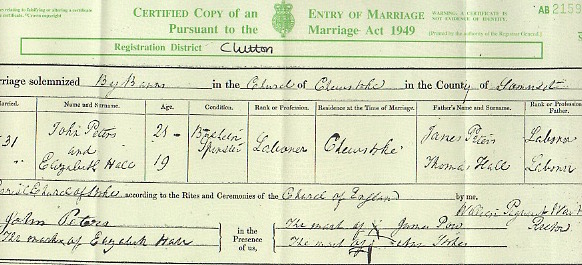
Their four eldest children, Henry, Louisa, Eliza and Benjamin Hall Peters were all
baptised at St Andrews church in Chew Stoke before the family returned to Chew Magna between 1847 and 1850. From then until the mid 1870s they lived in a cottage in Battles Lane on the western side of the village. and a further six children were baptised in the parish church. Charles, the youngest was christened on October 16th 1864 on the same day that a grandddaughter of John and Elizabeth was also. She was baptised Rosina Fear Peters and was the result of a liaison between Louisa and Samuel Fear, the son of a local farmer. Samuel was three years younger than Louisa and was obviously disinclined to marry her. Louisa had recourse to the law to obtain an allowance for her child and in the Western Gazette of 28th July 1865 the following notice was published:

Two years later, Samuel married another local girl, Hannah Fear (Fear was a very common name in Chew Magna) and later established a butcher’s shop in the village. Around this time Louisa moved to Bristol, for in September 1868 she married Stephen Bumstead in Bedminster. She gives her abode as West Street, but this may just be a convenience address to establish her presence for the calling of banns. The witnesses were Louisa’s brother, Benjamin and his fiancee, Ann Green. Ann’s family lived in West Street at this time. John and Elizabeth were still in Chew Magna when the 1871 Census was taken, but seemed to have moved to Bedminster in the next few years. John died there in 1878 and Elizabeth and her remaining children were living at Richmond Terrace in 1881. In 1901 Elizabeth is living in the household of Stephen and Louisa Bumstead at 1 Diamond Street, Bedminster. She died early in 1911 aged 90.
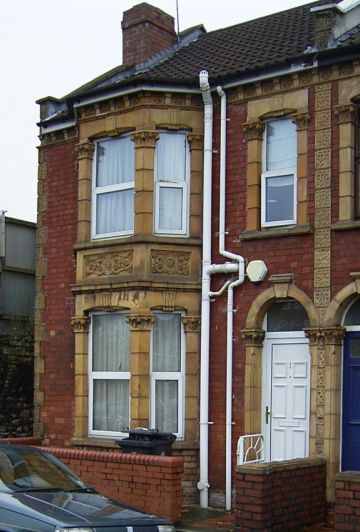
To conclude this account I shall summarise the lives of John and Elizabeth’s ten children:
Henry Peters (1840 – ?) the eldest, bore a name not used by either parents’ families before. He is with John and Elizabeth in 1841 and 1851, but in the 1861 Census he is living in the household of the Rev. Alfred Hensley at Grove in Nottinghamshire. He is unmarried and working as a groom. Thereafter no trace of a Henry Peters can be found, but he seems to resurface as the William Henry Peters who appears in records as Henry vanishes. This William Henry (often William H. Peters) is first found in the 1871 Census as a butler working for Salisbury Baxendale, a barrister and JP in Stanstead, Herts; his place of birth is Chew Stoke and his age 31. He married Hannah Elizabeth Phillips on the Isle of Wight in 1879, and they had two children, William Frederick Daniel, born at Sandown in 1880, and Florence Blanche Elizabeth, born in Chelsea in 1883. Another child died young. William Henry has not yet been found in 1881 or 1891, presumably he was away working and either not recorded or misrecorded, but Hannah is still on the Isle of Wight in the 1881 Census and in Chelsea in 1891. The latter is of great interest as, besides her children, she has living with her an Elizabeth Peters, a widow of 72 years described as “mother” to the head of household. Although her place of birth is given as Bristol (perhaps Hannah didn’t know any better – Elizabeth had lived there for the past 15 or so years) this must be Elizabeth, the widow of John Peters, and William Henry’s mother. Certainly Hannah’s mother was named Fanny Phillips.
In 1901 William Henry is back with the family who have moved to Streatham, and his occupation is given as “Jobbing Gardener”; in 1911, with both children having married, William Henry, together with Hannah, is back in service in the household of Robert Borradaile, a retired clergyman in Oxted, Surrey. William is a butler once more and Hannah the cook of the household. No definitive death record can be found for William Henry, although the most likely is in 1914. Hannah seems to have lived until 1947. Of their children, William became an architect with the London CC, but served in the RAMC during the First World War and died of a cerebral haemorrhage whilst in the army of occupation, near Bonn on May 2nd, 1919, leaving a son and daughter. Florence married Joshua Swift, a carpenter in 1903 at Wimbledon parish church. They had a large family and Florence died in 1970.
Louisa Peters (1842 – 1923) we have heard of above. Her husband, Stephen Bumstead moved (as many did at this period) from being a blacksmith to an engineer; in his case a stationary engine driver, working in the timberyards of Bristol. As well as Louisa’s daughter, Rosina, they raised two sons, Frederick Walter (1879 – 1947) and George Albert (1888 – 1976). Stephen died at the age of 59 in 1903. All three children married and raised families; Rosina married John Roberts in 1891, and they had five children, three boys and two girls. Frederick married Lily Price in 1905 and they had a son and five daughters, and George (always known as Bert) married Mabel Kate Flexney in 1914, and their only child was my father, Francis Albert Stephen Bumstead.
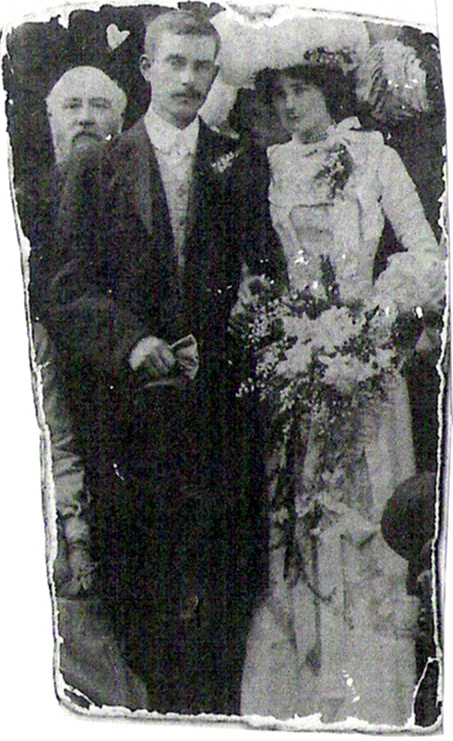
Frederick Walter Bumstead and Lily Price at their marriage 1905
In this damaged photo of Frederick’s wedding there is a tantalising glimpse of other family members. The gentleman behind Frederick’s shoulder could be a Peters uncle, and it seems there is a lady sitting to his left. This may be either Louisa, or more likely, Elizabeth Peters (nee Hall) who surely would have attended her grandson’s marriage.
Frederick was employed as a wood machinist for most of his life, whilst George Albert was a plumber and gas fitter, although during the First World War he worked at the Bristol aircraft factory at Filton. He was originally turned down for enlistment in 1914, owing to an injured wrist sustained in a cricket match, and later was in a reserved occupation and thus avoided military service.
Eliza Peters (1844 – ?) has proved fairly elusive. She married George Chapman, a carpenter in Bedminster in 1870 and they had two daughters; Sidonia Eliza Jane (1875 – 1881) and Lilian Gertrude (1879 – 1961). In 1871 Eliza and George were living in Whitchurch, near Bristol, and in 1881 and 1891 they are back in Bedminster. Thereafter there is nothing; there are a couple of possible deaths for a George Chapman, but none I can find for Eliza. In 1901 Lilian is living with her aunt Louisa Bumstead and six months later she married Alfred Greening with whom she had four children.
Benjamin Hall Peters (1847 – 1913) was named for his uncle, Elizabeth’s younger brother. We have seen above that he was a witness at the marriage of his sister, Louisa in 1868, along with Ann Green, whom he was to marry the following year. Ann’s family were market gardeners living in West Street, Bedminster, and the young couple remained with the Green family for many years. They had two daughters who died young (Annie Louisa 1870-72 and Annie Louise 1874-8) before two sons who survived; William Arthur born 1880 and Thomas Newland born 1883. Benjamin is shown as a porter in 1871, but in the following two censuses he is a gardener, no doubt working with his father-in-law. After the deaths of Ann’s parents Benjamin seems to have given up the business and is shown as a carter in 1901. Ann died a few years later and the 1911 census shows Benjamin returning to Chew Magna and working as a jobbing garderer again, two years before his death.
James Peters (1850 – 1928) was the first child of John and Elizabeth to be baptised in Chew Magna. He married Harriet Hembry Brimble in Bedminster in 1869 and two years later they were living in Bath where James is a railway porter, with a daughter Florence. By the time of the 1881 census, James and Harriet have moved to Newport in Monmouthshire and James is now a hair cutter; surprisingly they have a single daughter, Florence whose age is given as six. I can’t find a death for the child of ten years before, and the birth of this Florence was registered in Bedminster in 1875. However 1891 finds the family still in Newport with James now shown as a hairdressser and an employer. Also with them is James’ younger brother, Charles who is a hairdresser too.
Florence married William Serle in Bedminster in 1898 and it may be that the family had already returned to live there before as James and Harriet are living at 16 North Street, Bedminster in 1901. They are still there in 1911 and their granddaughter Phyllis Brookland Serle is living with them, as her parents left Bristol on the “Royal Edward”, bound for Halifax, Nova Scotia in February of that year. A newspaper report of May 1928 tells the sad story of James’ death. It appears he died of gas poisoning when a faulty tap in his bedroom was loosened by movement about the room. It seems as if his granddaughter Phyllis was still living with the family. Harriet died in 1937 and the register of 1939 still shows Phyllis living on her own at 16 North Street, Bedminster.
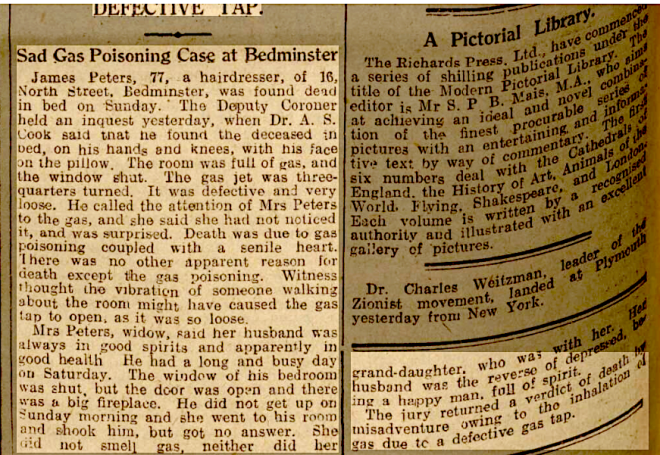
Jane Peters (1853 – 1924) moved to Bristol before her parents as she is shown in the 1871 census working as a domestic servant in the household of Charlotte Caudwell, a lodging house keeper, at 8 Vyvyan Terrace, Clifton, Bristol. At some time in the next few years she moved away and her marriage to Joseph Howes is recorded at Standon in Staffordshire early in 1877. In the census four years later, Joseph and Jane are living with Joseph’s widowed mother, Anne in Standon, where he is employed as an agricultural labourer. They have their two eldest children with them, Albert and George. Ten years later they have moved to 28, Gresty Road, Crewe in Cheshire where Joseph worked as a railway porter, and they now have another son, Charles and a daughter, Gertrude. Two further sons, Leonard and Reginald completed the family by the time of the 1901 Census, although this shows that another child had died at some time during Joseph and Jane’s marriage. A family memoir records that it was a happy and busy household, welcoming the young peoples’ friends with supper and games. All of the children married and had families and the photograph below shows Joseph and Jane at the occasion of their daughter, Gertrude’s marriage in 1921.
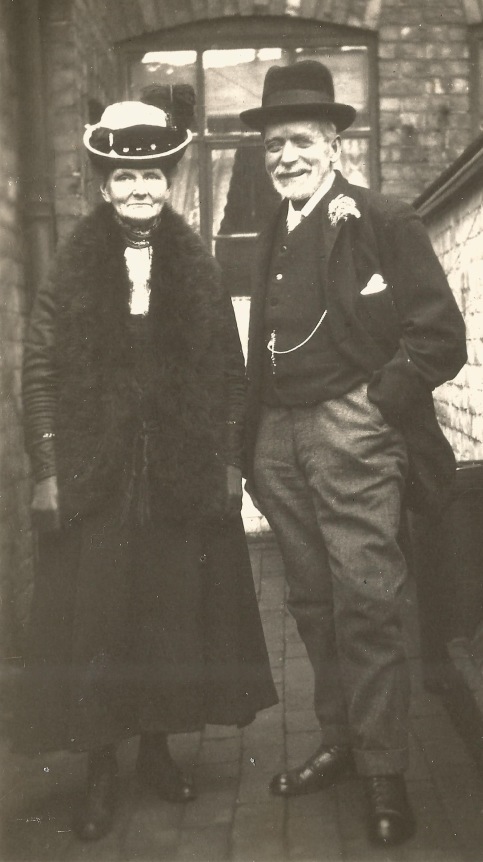
Jane died in 1924 and Joseph the following year.
Thomas Peters (1856 – 1893), John Peters (1858 – 1881) and Frederick Peters (1861 – 1882), the next three sons of John and Elizabeth Peters are shadowy figures, about which not much can be discovered. They are all living with their mother Elizabeth in the 1881 census at Richmond Terrace, Bedminster. Thomas and John are described as general labourers but Frederick has no occupation, and in the column that lists physical or mental disabilities the following appears:

I can only read this “quiet invalide”, but any suggestions as to a different meaning would be welcome. Was he perhaps in some type of withdrawn state? The enumerator has avoided using any of the suggestions at the heading of the column; imbecile, idiot or lunatic. It seems that Frederick died the following year and his brother John in the November of 1881. Thomas appears in the 1891 census as a lodger at the Exeter Inn in Southgate Street, Bath, but with no occupation and his death seems to be listed in Bedminster in 1893.
Charles Peters (1864 – 1947) was the youngest child of John and Elizabeth and was still at home with his mother and three brothers in 1881. His occupation is grocer’s assistant. Ten years later he had left Bristol and was living with his brother James in Newport, working for (and trained by?) him as a hairdresser. Whilst James had returned to Bedminster by 1901, Charles remained in Newport, working on his own account as a hairdresser. He had married Minnie Ann Rider in Bedminster in 1894 and together they had at least four children. There is some doubt as in the 1911 census return Charles has recorded that they have had four children, one of whom has died and yet then lists four children, all alive: Herbert Charles, William Henry, Violet May, and Daisy. At this time the family are living at 160 West Street, Bedminster with Charles again stating that he works on his own account, at home.
Of the children of Charles and Minnie, William Henry is a mystery. I can find no trace of him after 1911. Herbert married Lily Jenette Jones in 1923 and in the 1939 Register they have one person with them whose name is not available. This may be a son, Mervyn as there was a birth recorded in Bedminster in 1930 with a Peters father and Jones mother, but we can’t be sure. Herbert was a tobacconist and confectioner and at that date the family were living at his parents previous home of 160 West Street. Charles and Minnie had moved to 104 Chessel Street, Bedminster where they are shown on the Register along with daughter Daisy and her husband, Isaac Victor Oram. Violet married William Hamilton Bennett in 1924 and they had at least two children. 1939 found them at 10 Bath Street, opposite the site of George’s Brewery, where no doubt William worked in the fermenting department. Minnie Peters died in 1944 and Charles three years later, the last of John and Elizabeth’s children to die.
As an interesting footnote, Charles and Minnie’s next door neighbours at 106 Chessel Street were the Flexney family, and Charles’ nephew, George Albert Bumstead married Mabel Kate Flexney in 1914. Is it possible they met whilst Bert was visiting his uncle and aunt?
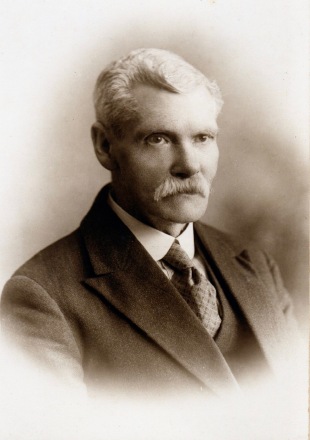
Charles Peters later in life
Acknowledgements: photographs of Jane & Joseph Howes, and Charles Peters: Lynne Gibson.
Photograph of Frederick and Lily Bumstead: Josephine Summers
Documents: The National Archive, Somerset Heritage Centre & National Newspaper Archive
Welcome to Geneabloggers! This is a great online community. I started a new blog on here this year. thehoneymoontrail.blogspot.com Maybe we should follow each other.
LikeLiked by 1 person
Hi and thanks for the welcome. I will visit your blog later and am happy to follow it,
Steve
LikeLike
You certainly have done a thorough job with this family history. Genealogy is a great adventure. There are always more questions. I just followed you. My blog are
thehoneymoontrail.blogspot.com
thestephensherwoodletters.blogspot.com
The last blog is on the Sherwood Family. They originally came from England. I have spent many years working on John and Lovisa Burtis Sherwood and their five children. Finally because of the submission of a patron to familysearch.org, I was able to find more on Sarah Sherwood Cramer. I had already found information on the descendants of her other four siblings.
Good luck in your blogging!
LikeLike
I had a good look at the Sherwood story today – very impressive work and I really loved the video on John Sherwood. I must have a go at something similar one day
Steve
LikeLike
Thank you so much for this excellent, thorough post about the Peters family! I am descended from Ann Peters, daughter of Robert, who married Richard Cox in Chew Magna in 1744. I’ve spent the last couple of days trying to piece together the Peters family and your information helped fill in a few gaps. My theory is that Robert Peters who married Mary Horwood is the son of Tobias, and brother of Tobias whose Quaker children went to Bristol. If you’d be interested in corresponding and exchanging information my email address is roseottley@gmail.com.
LikeLike
Thank you for your kind comments. I will be in touch via email very shortly
Steve
LikeLike